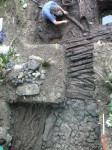 Archaeologists excavating the infilled Black Loch of Myrton on the Monreith estate in Wigtownshire, southwestern Scotland, have discovered that what they thought was an Iron Age crannog (a man-made island built in a lake or river) is actually an Iron Age “loch village,” a small town built on natural peat mounds in the lake, from the middle of the first century B.C. Lake villages have been discovered in England before, for example Glastonbury lake village in Somerset, but this is the first one found in Scotland, which means it’s the first loch village ever found.
Archaeologists excavating the infilled Black Loch of Myrton on the Monreith estate in Wigtownshire, southwestern Scotland, have discovered that what they thought was an Iron Age crannog (a man-made island built in a lake or river) is actually an Iron Age “loch village,” a small town built on natural peat mounds in the lake, from the middle of the first century B.C. Lake villages have been discovered in England before, for example Glastonbury lake village in Somerset, but this is the first one found in Scotland, which means it’s the first loch village ever found.
What initially appeared to be one of a small group of mounds before excavation was revealed to be a massive stone hearth complex at the centre of a roundhouse. The timber structure of the house has been preserved, with beams radiating out from the hearth forming the foundation, while the outer wall consists of a double-circuit of stakes.
The most surprising discovery was that the house was not built on top of an artificial foundation, but directly over the fen peat which had gradually filled in the loch. Rather than being a single crannog, as first thought, it appears to be a settlement of at least seven houses built in the wetlands around the small loch.
This find is as fortunate as it is historically significant. We know the Black Loch was subject to land reclamation efforts in the first half of the 19th  century because on the Ordnance Survey map of 1848 the loch itself is tiny and the adjacent land is labeled Black Loch Plantation. By 1880 the lake had been drained thoroughly enough to allow Sir Herbert Maxwell, 7th Baronet of Monreith, to excavate what he thought was a crannog and to recover Iron Age hammer stones and one whetstone. Those finds didn’t stop the attempts to keep the lake drained so the land could be farmed. Unfortunately for the farmers but fortunately for archaeology, drainage couldn’t keep up with the boggy, peaty terrain. The land was used for pasture when it got too wet to plow and by 1993, the crannog could no longer be seen.
century because on the Ordnance Survey map of 1848 the loch itself is tiny and the adjacent land is labeled Black Loch Plantation. By 1880 the lake had been drained thoroughly enough to allow Sir Herbert Maxwell, 7th Baronet of Monreith, to excavate what he thought was a crannog and to recover Iron Age hammer stones and one whetstone. Those finds didn’t stop the attempts to keep the lake drained so the land could be farmed. Unfortunately for the farmers but fortunately for archaeology, drainage couldn’t keep up with the boggy, peaty terrain. The land was used for pasture when it got too wet to plow and by 1993, the crannog could no longer be seen.
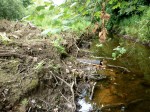 In 2010, new field drains were cut in Black Loch and a run-off channel for the new drains to empty into was dug underneath a forested area near the center of the loch to connect to one of the 19th century drains. During the digging of the run-off channel, worked oak timbers were discovered. A reconnaissance survey by AOC Archaeology Group followed in which test pits were dug around the crannog-like mound and core
In 2010, new field drains were cut in Black Loch and a run-off channel for the new drains to empty into was dug underneath a forested area near the center of the loch to connect to one of the 19th century drains. During the digging of the run-off channel, worked oak timbers were discovered. A reconnaissance survey by AOC Archaeology Group followed in which test pits were dug around the crannog-like mound and core 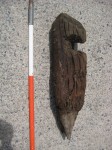 samples taken along the channel. The team found charcoal in the core samples and horizontal timbers in the test pits. Radiocarbon dating of the timbers found that they date to middle of the first millennium B.C., the early Iron Age.
samples taken along the channel. The team found charcoal in the core samples and horizontal timbers in the test pits. Radiocarbon dating of the timbers found that they date to middle of the first millennium B.C., the early Iron Age.
These elements are often found in crannog excavations, and since the White Loch right next to the Black has a visible crannog, archaeologists had good reason to believe that’s what they had found here too: an early Iron Age crannog. Their final assessment was the site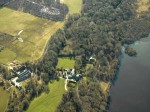 was archaeologically significant and that the new drainage channels posed a serious threat to the timbers and other organic deposits that had been preserved for thousands of years in the wet, peaty environment.
was archaeologically significant and that the new drainage channels posed a serious threat to the timbers and other organic deposits that had been preserved for thousands of years in the wet, peaty environment.
Three years later, funds from Historic Scotland allowed AOC Archaeology Group to return to the site for a pilot excavation this July. Local volunteers also participated in the dig. They found the alder timbers radiating out from the central hearth and outside the radial timbers was a ring of small cobbles that were probably used to keep the perimeter of the roundhouse dry. As 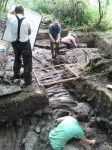 they continued to dig down, archaeologists found the earliest iteration of the hearth. This one hearth was reused at least three times, probably by different people who occupied the site over the years.
they continued to dig down, archaeologists found the earliest iteration of the hearth. This one hearth was reused at least three times, probably by different people who occupied the site over the years.
Archaeologists have sampled, documented and photographed every timber before removing them to the laboratory for conservation and further analysis, but even so they’ve barely scratched the surface of this unique and important find. They hope to be able to return soon for a more extensive archaeological excavation.